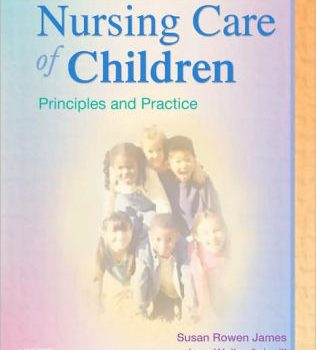Test Bank For Nursing Care of Children Principles and Practice 3rd edition by Susan R. James
James: Nursing Care of Children: Principles and Practice, 3rd Edition
Test Bank
Chapter 03: Communicating with Children
MULTIPLE CHOICE
1. Which of the following information would the nurse include when preparing a 5-year-old child for a cardiac catheterization?
a.
A detailed explanation of the procedure
b.
A description of what the child will feel and see during procedure
c.
An explanation about the dye that will go directly into his vein
d.
An assurance to the child that he and the nurse can talk about the procedure when it is over
ANS: B
Feedback
A
Explaining the procedure in detail is probably more than the 5-year-old child can comprehend and it will produce anxiety.
B
For a preschooler, the provision of sensory information about what to expect during the procedure will enhance the child’s ability to cope with the events of the procedure and will decrease anxiety.
C
Using the word “dye” with a preschooler can be frightening for the child.
D
The child needs information before the procedure.
DIF:Cognitive Level: ApplicationREF:Text Reference: pg 59
OBJ:Nursing Process Step: Planning
MSC: NCLEX: Health Promotion and Maintenance
2.Who are the “experts” in planning for the care of a 9-year-old child with a profound sensory impairment who is hospitalized for surgery?
a.
The child’s parents
b.
The child’s teacher
c.
The case manager
d.
The primary nurse
ANS: A
Feedback
A
The parents, as primary caregivers, can identify the child’s needs to help develop an effective, individualized plan of care.
B
The child’s teacher is not as “expert” as her parents for planning her care.
C
The case manager is not as aware as the parents are of the child’s individual needs.
D
The primary nurse would use the child’s parents as resources in planning the best approach to the child’s care.
DIF:Cognitive Level: ComprehensionREF:Text Reference: pg 60
OBJ: Nursing Process Step: Planning MSC: NCLEX: Psychosocial Integrity
3.Which of the following is an effective technique for communicating with toddlers?
a.
Have the toddler make up a story from a picture.
b.
Involve the toddler in dramatic play with dress-up clothing.
c.
Repeatedly read familiar stories to the child.
d.
Ask the toddler to draw pictures of his fears.
ANS: C
Feedback
A
Most toddlers do not have the vocabulary to make up stories.
B
Dramatic play is associated with older children.
C
Ritualism is a characteristic of the toddler period. By repeating familiar stories and other rituals, the toddler feels a sense of control, which facilitates communication.
D
Toddlers probably are not capable of drawing or verbally articulating their fears.
DIF:Cognitive Level: ApplicationREF:Text Reference: pg 55
OBJ:Nursing Process Step: Planning
MSC: NCLEX: Health Promotion and Maintenance
4.What is the most important consideration for effectively communicating with a child?
a.
The child’s chronologic age
b.
The parent-child interaction
c.
The child’s receptiveness
d.
The child’s developmental level
ANS: D
Feedback
A
The child’s age may not correspond with the developmental level; therefore, it is not the most important consideration for communicating with children.
B
Parent-child interaction is useful in planning communication with children, but it is not the primary factor in establishing effective communication.
C
The child’s receptiveness is a consideration in evaluating the effectiveness of communication.
D
The child’s developmental level is the basis for selecting the terminology and structure of the message most likely to be understood by the child.
DIF:Cognitive Level: ComprehensionREF:Text Reference: pg 54
OBJ:Nursing Process Step: Assessment
MSC: NCLEX: Health Promotion and Maintenance
5.Which of the following behaviors is most likely to encourage open communication?
a.
Avoiding eye contact
b.
Folding arms across chest
c.
Standing with head bowed
d.
Soft stance with arms loose at the side
ANS: D
Feedback
A
Avoiding eye contact does not facilitate communication.
B
Folding arms across the chest is a closed-body posture, which does not facilitate communication.
C
Standing with head bowed is a closed-body posture, which does not facilitate communication.
D
A swaying body with arms loose at the sides suggests openness.
DIF:Cognitive Level: ComprehensionREF:Text Reference: pg 50
OBJ:Nursing Process Step: Implementation
MSC: NCLEX: Psychosocial Integrity
6.Which of the following strategies is most likely to encourage a child to express his feelings about the hospital experience?
a.
Avoiding periods of silence
b.
Asking direct questions
c.
Sharing personal experiences
d.
Using open-ended questions
ANS: D
Feedback
A
Periods of silence can serve to facilitate communication.
B
Direct questions can threaten and block communication.
C
Talking about yourself shifts the focus of the conversation away from the child.
D
Open-ended questions encourage conversation.
DIF:Cognitive Level: ApplicationREF:Text Reference: pg 50
OBJ: Nursing Process Step: Planning MSC: NCLEX: Psychosocial Integrity
7.Which of the following is the most appropriate question to ask when interviewing an adolescent to encourage conversation?
a.
“Are you in school?”
b.
“Are you doing well in school?”
c.
“How is school going for you?”
d.
“How do your parents feel about your grades?”
ANS: C









Reviews
There are no reviews yet.